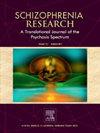比较精神分裂症患者和健康对照者血浆来源的细胞外囊泡的蛋白质组谱:一项初步研究
IF 3.5
2区 医学
Q1 PSYCHIATRY
引用次数: 0
摘要
研究细胞外囊泡(ev) -具有多种分子载体的微小细胞间通讯工具-可能有助于了解精神分裂症(SCZ)的神经病理学和病理生理学。在这里,我们关注血浆源性EVs的蛋白质谱,目的是检测SCZ患者与健康对照(hc)之间的差异。方法从73例SCZ患者和77例hc患者的血浆中分离sev,采用纳米颗粒跟踪分析、电镜观察和Western blot分析进行评价。采用液相色谱-质谱联用技术对EV蛋白进行鉴定。蛋白质组学数据采用逻辑回归分析。结果共鉴定出1659个蛋白,其中1021个蛋白进行了分析,每组(SCZ组和HC组)均有50%以上的参与者获得了定量数据。在两组之间比较这些蛋白质没有显着差异。基于非校正显著p值的蛋白质的富集分析显示,与补体系统相关的途径显著富集。虽然两组间补体成分比较无明显差异,但表明抗精神病药物和病程可能影响EV蛋白水平。总的来说,尽管我们的研究结果强调了药物使用和疾病持续时间对EV蛋白水平的重要性,但它们表明补体系统可能参与了SCZ的发病机制。虽然这项初步研究的结果需要在更大规模的研究中得到复制,但它们可能有助于阐明SCZ的病理生理机制。本文章由计算机程序翻译,如有差异,请以英文原文为准。
Comparing the proteome profiling of plasma-derived extracellular vesicles in individuals with schizophrenia and healthy controls: a pilot study
Background
Studying extracellular vesicles (EVs)—tiny intercellular communicators with a diverse molecular cargo—may provide insight into the poorly understood neuropathology and pathophysiology of schizophrenia (SCZ). Here, we focused on the protein profile of plasma-derived EVs with the aim to detect differences between individuals with SCZ and healthy controls (HCs).
Methods
EVs were isolated from blood plasma of 73 individuals with SCZ and 77 HCs and evaluated by nanoparticle tracking analysis, electron microscopy, and Western blot analysis. EV proteins were identified by liquid chromatography coupled with mass spectrometry. Proteomic data were analyzed using logistic regression analyses.
Results
A total of 1659 proteins were identified, and analyses were performed with the 1021 proteins with quantitative data available for more than 50 % of the participants in each group (SCZ and HC). Comparing these proteins between the two groups showed no significant differences. An enrichment analysis based on the proteins with a noncorrected significant p value revealed a significant enrichment of pathways connected to complement system. Although comparison of complement components between the two groups did not show significant differences, but it demonstrated that antipsychotics and duration of illness may affect EV protein levels.
Conclusion
Overall, even as our findings highlight the importance of medication use and duration of illness on EV protein levels, they suggest that the complement system may be involved in the etiopathology of SCZ. Although, the results of this pilot study need to be replicated in larger research, they may help elucidate the mechanisms involved in the pathophysiology of SCZ.
求助全文
通过发布文献求助,成功后即可免费获取论文全文。
去求助
来源期刊

Schizophrenia Research
医学-精神病学
CiteScore
7.50
自引率
8.90%
发文量
429
审稿时长
10.2 weeks
期刊介绍:
As official journal of the Schizophrenia International Research Society (SIRS) Schizophrenia Research is THE journal of choice for international researchers and clinicians to share their work with the global schizophrenia research community. More than 6000 institutes have online or print (or both) access to this journal - the largest specialist journal in the field, with the largest readership!
Schizophrenia Research''s time to first decision is as fast as 6 weeks and its publishing speed is as fast as 4 weeks until online publication (corrected proof/Article in Press) after acceptance and 14 weeks from acceptance until publication in a printed issue.
The journal publishes novel papers that really contribute to understanding the biology and treatment of schizophrenic disorders; Schizophrenia Research brings together biological, clinical and psychological research in order to stimulate the synthesis of findings from all disciplines involved in improving patient outcomes in schizophrenia.
 求助内容:
求助内容: 应助结果提醒方式:
应助结果提醒方式:


